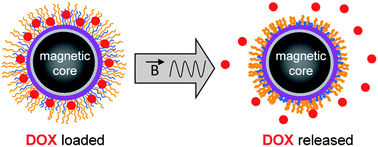Over the past decade, considerable interest has been devoted to the development of a variety of nanoparticle-based drug delivery systems for nanomedicine. A large number of drug release strategies have been proposed and may be classified according to the nature of the stimulus used to trigger the process. In this context, Lecommandoux, Schatz and co-workers reported on the design of a thermoresponsive hybrid system for drug delivery purposes by modifying the surface of silica-coated magnetic lanthanum strontium manganite nanoparticles with adsorbed polyether-b-poly(L-lysine) block copolymers. They demonstrated that the thermoresponsiveness of the assemblies was controlled by the ethylene oxide/propylene oxide ratio in the polymer brush and the corresponding LCST of the polyether blocks. The polarity of the polymer layer was also varied to maximize the encapsulation efficiency of a moderately hydrophobic drug like doxorubicin. Eventually, the release of doxorubicin through the synergistic effects of thermoresponsive polymer brushes and magnetically induced heating was demonstrated.
Thermoresponsive polymer brush-functionalized magnetic manganite nanoparticles for remotely triggered drug release by Stéphanie Louguet, Bérengère Rousseau, Romain Epherre, Nicolas Guidolin, Graziella Goglio, Stéphane Mornet, Etienne Duguet, Sébastien Lecommandoux and Christophe Schatz, Polym. Chem., 2012, 3, 1408-1417.
To keep up-to-date with all the latest research, sign up for the journal’s e-alerts or RSS feeds or follow Polymer Chemistryon Twitter or Facebook.











